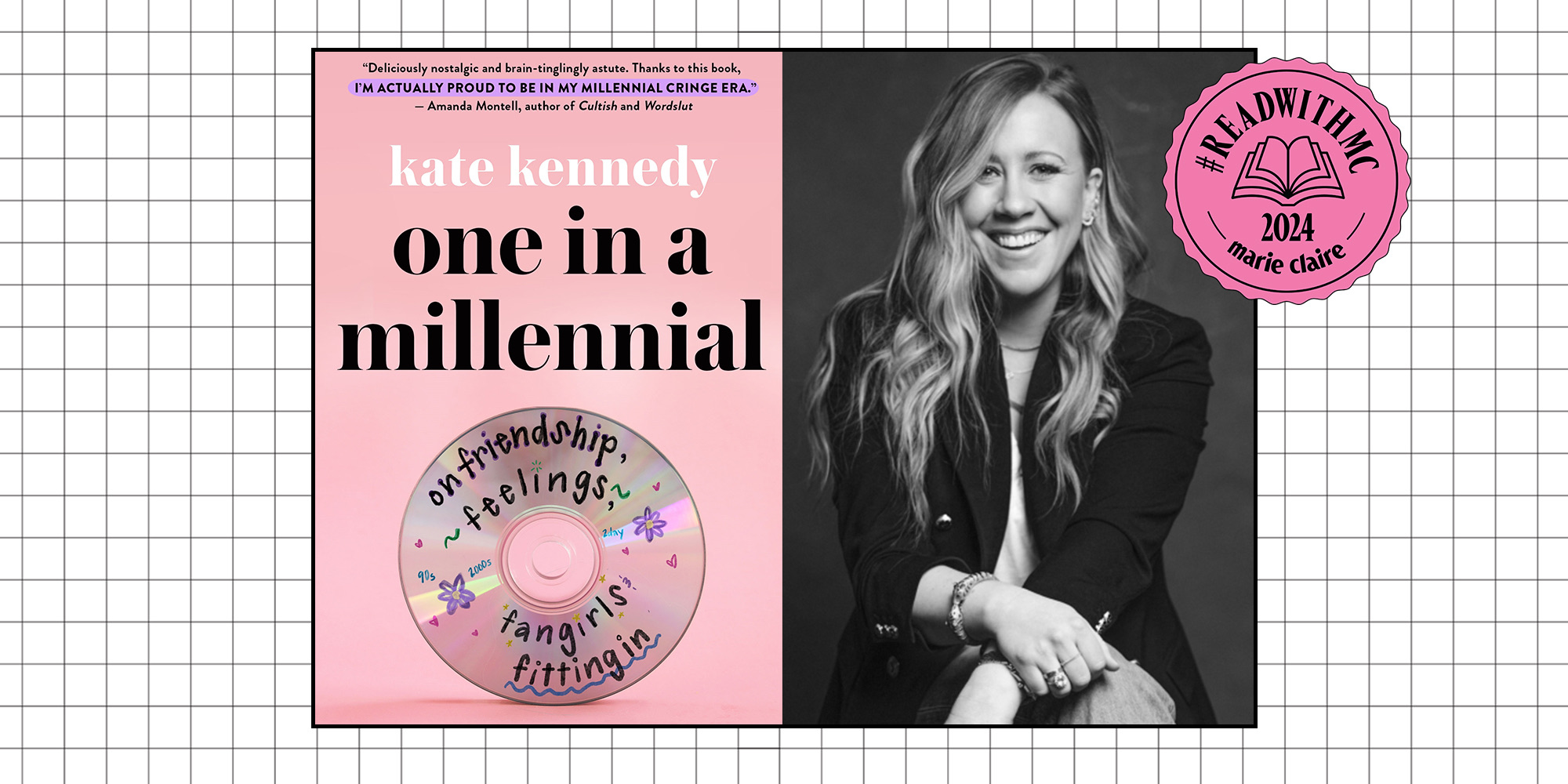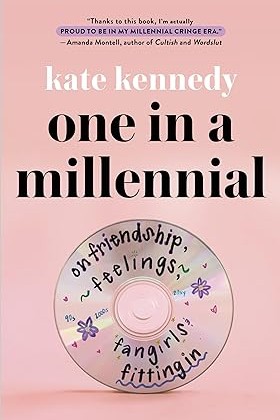‘One In a Millennial’ Is Our January Book Club Pick
Read an excerpt of Kate Kennedy’s book here, then dive in with us throughout the month.


Welcome to #ReadWithMC—Marie Claire's virtual book club. It's nice to have you! In January, we're reading Kate Kennedy’s One In a Millennial: On Friendships, Feelings, Fangirls, and Fitting In, a book that encapsulates the experience of being a millennial largely through the lens of pop culture—an exploration of the millennial zeitgeist and the life lessons learned (for better and for worse) from being a member of this generation. Kennedy is a pop culture commentator and host of the popular millennial-focused podcast “Be There in Five.” Read an excerpt from the book below, then find out how to participate. (You really don't have to leave your couch!)
1: Limited To
In the early nineties, Mattel debuted a short-lived edition of their iconic dolls called Teen Talk Barbie. She was their first talking doll in decades, and finally, young girls could have a more modernized talking Barbie to represent their plight. Each Teen Talk Barbie would say four randomly selected phrases (from the 270 that were preprogrammed) upon pushing a button, including:
“Will we ever have enough clothes?” “I love shopping!”
“Do you have a crush on anyone?” “I love romantic music.”
“Meet me at the mall.”
“Let’s plan our dream wedding!” “Wanna have a pizza party?” “Wouldn’t you love to be a lifeguard?”
There were endless combinations of phrases for each doll, but those are a few of my favorites. However, this was not a favorite doll among many parents and activist groups, because depending on the four phrases she rotated through, it was unlikely you’d receive a well-rounded Barbie with a balance of topics related to school, boys, shopping, and hobbies within the random choosing of four out of 270 phrases, though I don’t know the exact statistics. In my defense, I wholeheartedly agree with the phrase Teen Talk Barbie said that ultimately got her pulled off shelves:
Get exclusive access to fashion and beauty trends, hot-off-the-press celebrity news, and more.
“Math class is tough!”
In short, she is me. I am her. Math class really was tough for me; the mall was my third place; I loved clothes, boys, love songs, and pizza parties. And I have a pulse and grew up in the nineties, so of course, I’ve always glamourized lifeguard culture. According to an article from October 1992 in the Chicago Tribune titled “Barbie! Say it isn’t so!” even though some dolls said, “Let’s start a business!” or “I’m studying to be a doctor!,” depending on the phrases and the order in which they were said, Teen Talk Barbie’s interests could appear problematically narrow for young girls, causing the American Association of University Women and many parents to protest her existence successfully. Initially, the ask was to remove the phrase about math class, but the manufacturer had no way of knowing which Teen Talk Barbies on the shelves said which phrases, so it would’ve been impossible to recall and reprogram them.
So, what were owners of Teen Talk Barbie allegedly offered as a replacement for the controversial dialogue? A mute model, aka a doll that said nothing.
Early on, I owned my truth and proudly chatted about the hyperfeminine things I liked, before I understood their labeling as superficial, only to be silenced when I was told they aren't things a woman should like in order to be taken seriously.
Kate Kennedy

Kate Kennedy
This has been my experience in life trying to navigate my feminine interests. Early on, I owned my truth and proudly chatted about the hyperfeminine things I liked, before I understood their labeling as superficial, only to be silenced when I was told they aren’t things a woman should like in order to be taken seriously. You’ll later read how this has impacted me well into my thirties, where I now feel the need to order a pumpkin spice latte (PSL) incognito, so I don’t appear too “basic” upon drinking a cozy fall treat. But in the context of “Math class is tough!” I genuinely understand the backlash; if we want toys to serve as role models, this wasn’t exactly helpful in getting more young women engaged with STEM fields that (especially at the time) were marked by our severe underrepresentation. But the doll was developed from a great deal of market research and wasn’t designed to be something to aspire to; rather, it was supposed to meet young girls where they were, serving more as one of their peers. And in the nineties, I was less of a woman in STEM and more of a girl who just wanted to have nice stems, happily (if not naïvely) existing with my peers somewhere between “Do you have a crush on anyone?” and “Meet me at the mall!”
As a kid I was shy, curious, and sensitive, and I surrounded myself with things that dared to be bolder and less plain than I felt.
Kate Kennedy
As a kid, I was shy, curious, and sensitive, and I surrounded myself with things that dared to be bolder and less plain than I felt. From observing the popular girls with big personalities to the glitter and glamour of pop stars to the self-expression I found in consumerism, literally making my every day a little more glittery with tubs of sparkly body gel. I started by studying my sister, Kelly; we were four years apart, and her world seemed much cooler than mine. From a young age, pop culture served as a unifier, bridging the age gap with our shared love of music, TV, and light crafting. When I think about it, she and her best friend, Monica, were my original influencers, and I remember a lot about elementary school, probably because I was attempting to collect enough data by copying their every move. I’d marvel at the craftsmanship of their oversized sweatshirts with ambiguously sourced iron-on decals outlined with puff paints, studying the effort put into matching the design of a folded-down turtleneck underneath, worn over stirrup leggings sensibly anchored into a pair of Keds. Monica said that her dream car was a Mazda Miata, and for years I’d tell people that my dream car, too, was a Mazda Miata, never having seen one before. I could often be found sporting one of Kelly’s Peace Frog T-shirts to school, so everyone knew I was cultured in that mall-kiosk sort of way, and I was green with envy when she was old enough to hit up the Piercing Pagoda and have some sixteen-year-old probably named Trevor pierce her ears, leaving me in the dust to oversee our collection of clip-on and stick-on earrings.
Our shared love of pop culture started to wear on me when we became fragmented by the entertainment that was considered age-appropriate. But the perk of this age difference was that it was a dream to sneak into her room and get to consume more mature content, stealing her Romeo + Juliet soundtrack at every turn so I could giggle at the band name “Butthole Surfers,” or unknowingly curse the name of my beloved Uncle Joey via scream-singing “You Oughta Know,” which I later found out was rumored to be about Full House’s Dave Coulier. Much to the discontent of my ears (but to the delight of my eyes!), Kelly dabbled in floor-to-ceiling nineties door beads in high school, which turned my covert operation of breaking into her room into an obvious criminal cacophony.
From a young age, pop culture served as a unifier.
Kate Kennedy
While door beads were a stunning interior accent for a teenager (which Limited Too and Britney’s Oops! . . . I Did It Again cover dreams were made of), they were also profoundly impractical. They get caught in your hair, snag the fibers of your sweater, and make it incredibly difficult to carry things in and out of the room. On top of that, they were also incredibly loud, waking us all up in the middle of the night, like an indoor plastic wind chime nobody asked for. When the noise was brought to her attention, instead of removing the door beads, she decided her best bet was to military-style crawl under them at night every single time she came and went from her room. To this day, I’ve never witnessed such a commitment to aesthetics at the expense of practicality. For any doubts cast her way about her love of spirited décor, she casts another seasonal throw pillow onto her couch in celebration of her taste, and I have always loved this about her.
From One in a Millennial: On Friendship, Feelings, Fangirls, and Fitting In by Kate Kennedy. Copyright © 2024 by the author and reprinted by permission of St. Martin’s Publishing Group.

Rachel Burchfield is a writer, editor, and podcaster whose primary interests are fashion and beauty, society and culture, and, most especially, the British Royal Family and other royal families around the world. She serves as Marie Claire’s Senior Celebrity and Royals Editor and has also contributed to publications like Allure, Cosmopolitan, Elle, Glamour, Harper’s Bazaar, InStyle, People, Vanity Fair, Vogue, and W, among others. Before taking on her current role with Marie Claire, Rachel served as its Weekend Editor and later Royals Editor. She is the cohost of Podcast Royal, a show that was named a top five royal podcast by The New York Times. A voracious reader and lover of books, Rachel also hosts I’d Rather Be Reading, which spotlights the best current nonfiction books hitting the market and interviews the authors of them. Rachel frequently appears as a media commentator, and she or her work has appeared on outlets like NBC’s Today Show, ABC’s Good Morning America, CNN, and more.
